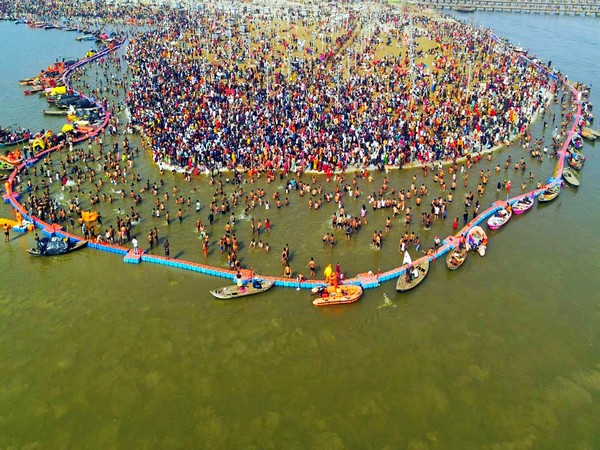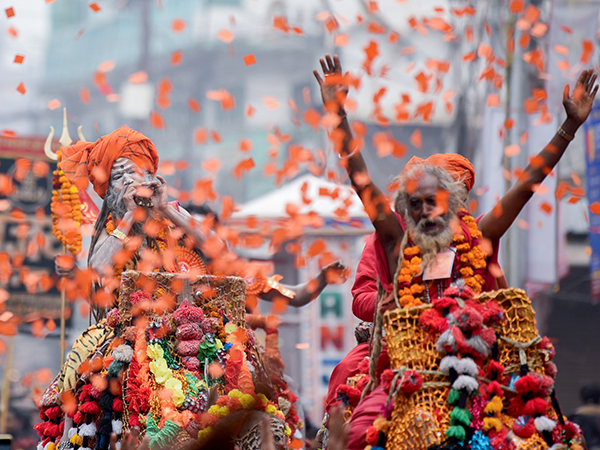|
|

|
|


The Kumbh Mela, believed to be the largest religious gathering on earth is held every 12 years on the banks of the 'Triveni Sangam'- the confluence of the holy rivers Ganga, Yamuna and the mythical Saraswathi. The Mela alternates between Nasik, Allahabad, Ujjain and Haridwar every three years. The one celebrated at the Holy Triveni Sangam in Prayagraj (formerly Allahabad or Illahabad), 'Maha Kumbh', is the largest and holiest of them. The Mela which lasts for a whole month, is attended by millions of devotees from India and abroad, including Sadhus and Spiritual leaders.

A holy dip in the sacred waters is believed to cleanse the
soul. The Sangam comes alive during Kumbh and Ardh Kumbh with an enormous
temporary township springing up on the vacant land on the Allahabad side of the
river. The main bathing ritual of the Kumbh is the 'Shahi Snan' which will take
place on the days of Makar Sankranti, Mauni Amavasya, and Basant Panchami.

'Mahakumbh' is recognized by UNESCO as an Intangible Cultural
Heritage of Humanity, a spiritual confluence that transcends barriers of
language, caste, creed, and sect. Seers and saints, from various sects,
including Shaivism, Shaktism, Vaishnavism, Udasin, Nath, Kabirpanthi, Raidas,
Bharshiv, Aghori, and Kapalik, come together to perform their rituals, offer
prayers, and take holy dip in the Ganga. Some have peculiar names, appearances
and showcase their unique talents at the Sangam. Devotees seek blessings from
sages and ascetics, visit temples for darshan, and share meals together in any
of the numerous community kitchens (Bhandaras) which remain open day and night,
symbolizing the tradition of unity and equality.
Visitors from around the world are often left in awe as they witness people from different castes, classes, languages, lifestyles, and traditions coming together at the Sangam to perform rituals, offer prayers, and take a holy dip.
Legend behind Kumbh Mela
The legend goes thus- the gods and the demons fight for a pot of nectar (Amrit Kumbh): the nectar of immortality. Lord Vishnu, disguising himself as an enchantress (Mohini), seized the nectar from the demons. While fleeing from the evil ones, Lord Vishnu passed the nectar on to his winged mount, Garuda. The demons finally caught up with Garuda and in the ensuing struggle, a few drops of the precious nectar fell on Allahabad, Nasik, Haridwar and Ujjain. Since then, the Kumbh Mela has been held in all these places, alternatively, every 3 years.
Ardh Kumbh Mela and Magh Mela
The Ardh or half Kumbh, is held every six years on the banks of Sangam in
Allahabad. Second only to the Kumbh in sanctity, the Ardh Kumbh also attracts
devouts in millions, from all over the world.
Magh Mela is an annual event held at the Sangam.
The area was known as 'Prayag' in ancient times, then Akbar founded the city named Ilahabas which later became Allahabad. Again the city was officially renamed as Prayagraj on 16th October 2018.
How to get there
Air : The Allahabad Domestic Airport, also known as Bamrauli Air Force Base, is 12 Km from Prayagraj and serves only a limited number of cities in India. The other nearest airports are Varanasi (120 Kms from Allahabad) and Lucknow (200 Kms from Allahabad).
Rail: Allahabad junction now Prayagraj Junction (station code: PRYJ) is well connected by trains with all major cities. Trains from all metros and major cities cross Prayagraj. viz. Kolkata, Delhi, Jaipur, Lucknow and Mumbai
Road: Prayagraj, on National Highways 2 and 27, is connected to all parts of the country by good motorable all-weather roads. State of U.P. (UPSRTC) runs buses (coaches) from all major cities in U.P. to Prayagraj. Travel agencies operating in all major cities can provide cars on rentals with chauffeur at reasonable cost.
Kumbh Mela Photos |
more photos |